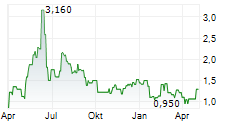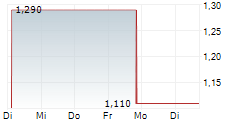
SHELTON, CT / ACCESSWIRE / August 26, 2024 / NanoViricides, Inc. (NYSE American:NNVC) (the "Company"), a clinical stage global leader in broad-spectrum antiviral nanomedicines, reports today that it is investigating the possibility of using NV-387 for the treatment of MPOX patients under the WHO MEURI protocol, in light of the recent WHO PHEIC (Public Health Emergency of International Concern) declaration for the current 2024 MPOX outbreak that is rapidly spreading into more than ten countries in Africa with additional cases detected in Thailand and Sweden.
MEURI, i.e. Monitored Emergency Use of Unregistered and Investigational Interventions, is an ethical protocol developed by the World Health Organization to evaluate the potential use of experimental drugs in the event of public health emergencies (https://en.wikipedia.org/wiki/Monitored_Emergency_Use_of_Unregistered_and_Investigational_Interventions).
The Company believes that the MEURI protocol may be applicable for the evaluation of NV-387 for the treatment of MPOX infection in patients. NV-387 has completed Phase I clinical trial for safety and tolerability studies in healthy subjects with no adverse events reported indicating excellent safety and tolerability. NV-387 has demonstrated strong improvement in survival in animal model studies matching that of the currently approved drug, tecovirimat, indicating excellent effectiveness. MPOX Clade 1/1b require development of new therapeutics due to limitations of existing therapies.
Survival Lifespan of Lethally Infected Mice - Intradigital Skin Footpad Infection with Ectromelia Virus (Model for MPOX, Smallpox) | |||
Treatment | Survival, Days | Increase in Survival, Days | Increase in Survival, % |
NV-387, Oral | 14 | 6 | 75% |
Tecovirimat, Oral | 14 | 6 | 75% |
NV-387-m-T, Oral | 17 | 9 | 112.5% |
Vehicle | 8 | 0 | 0% |
Additionally, the Company has also found that NV-387 was superior to or equivalent to existing drugs in non-clinical animal trials in the case of three major classes of respiratory viruses: RSV, Influenza, and COVID; the so-called "triple-demic" respiratory viruses. The Company believes that NV-387, as a single broad-spectrum antiviral drug that can treat a large number of viruses, could be as revolutionary for the treatment of viral infections as penicillin was to bacterial infections, when its effectiveness is proven in human clinical trials.
The current 2024 MPOX epidemic is primarily caused by a variant of MPOX virus of Clade 1, called Clade 1b, with Clade 1 cases also present. Clade 1 MPOX has been known to cause more severe disease and greater fatalities than the Clade 2 MPOX that caused a limited global pandemic in 2022. MPOX Clade 1b is spreading more rapidly than its parent Clade 1, and therefore is considered more transmissible and is anticipated to be more severe than Clade 2.
New treatments are needed to combat the recurring MPOX pandemics. A few vaccines are available, developed as smallpox vaccines, but are in short supply. The only currently approved treatment for smallpox, namely tecovirimat (TPOXX®, Siga), was used in the Clade 2 MPOX epidemic in 2022. However, it is reported that initial results from a recent randomised controlled trial - the best kind of medical evidence - in the DRC suggest that tecovirimat did not speed up healing of painful lesions in children and adults infected with the Clade I variant of MPOX, which is driving the ongoing outbreak (https://www.msn.com/en-us/health/other/how-deadly-is-mpox-and-what-treatments-are-available/ar-AA1pkpXl). Brincidofovir (Chimerix) was recently approved for smallpox but in MPOX patients it caused drug-induced liver injury and has not been used further.
NV-387, the Company's novel broad-spectrum antiviral treatment was found in an animal model study emulating the direct skin infection by the virus to be as effective as the current approved drug tecovirimat. Direct skin infection is thought to be the major mode of transmission of the MPOX virus in the current epidemic of MPOX Clade 1 and Clade 1b, just as it was found to be the main mode of transmission in the 2022 MPOX epidemic of Clade 2.
In this lethal animal model virus infection study, oral treatment with NV-387 led to the same extent of increase in survival as oral treatment with tecovirimat. Additionally, treatment with the Company's formulation containing both NV-387 and tecovirimat, called NV-387-m-T, led to a much greater improvement in survival than either NV-387 or tecovirimat. Increase in survival is a quantitative indicator of effectiveness of the treatment in this model.
In this study, mice were lethally infected with the ectromelia virus, intradigitally by scoring skin on footpads. This model emulates direct infection of the virus by skin abrasion. It is believed that direct skin-to-skin contact is the dominant mode of transmission of MPOX in the current 2024 MPOX Clade 1/1b global public health emergency, as it was in the 2022 MPOX Clade 2 epidemic. Mice in different groups were were treated orally with tecovirimat, NV-387, or NV-387-m-T, or vehicle (negative control). Ectromelia virus is in the same class as smallpox and mpox viruses, and has been used as a validated model for orthopoxvirus drug development.
NV-387 acts by a novel mechanism that the Company calls "Re-Infection Inhibition", meaning the drug blocks the virus from being able to infect cells in the first place, a mechanism which is distinctly different from that of neutralizing antibodies or entry inhibitors. Tecovirimat, on the other hand, inhibits the release of the virus particles after they have already made thousands of copies in a cell. These mechanisms are complimentary to each other, leading to enhanced effect when both drugs are used simultaneously. The Company developed a special oral formulation for being able to deliver both drugs simultaneously, called NV-387-m-T.
What is a "nanoviricide"?
A "nanoviricide" is a uniform polymer that self-assembles into nanoscale droplets called "micelles", that carries on its surface mimics of the cell-side receptor of the virus, and that hides in its belly lipid tentacles. It can also hold other guest APIs in its belly if needed. The nanoviricide thus "looks like" a cell to the virus, and the virus is fooled into binding it. Once the virus binds, we believe, the flexible and shape-shifting nanoviricide micelle would spread over the virus particle by virtue of merging the lipid tentacles that are hidden in its belly into the virus surface, in a well known process called "lipid-lipid mixing." We believe this would destabilize the virus particle, uproot the viral glycoproteins required for binding to and entering the host cell, and thus render the virus particle incapable of infecting a cell.
About NanoViricides
NanoViricides, Inc. (the "Company") (www.nanoviricides.com) is a development stage company that is creating special purpose nanomaterials for antiviral therapy. The Company's novel nanoviricide class of drug candidates are designed to specifically attack enveloped virus particles and to dismantle them. Our lead drug candidate is NV-387 for the treatment of RSV, COVID, Long COVID, Influenza, and other respiratory viral infections. NV-387 also has demonstrated activity against an orthopoxvirus in animal model studies. Our other advanced candidate is NV-HHV-1 for the treatment of Shingles. The Company cannot project an exact date for filing an IND for any of its drugs because of dependence on a number of external collaborators and consultants. The Company is currently focused on advancing NV-387 into Phase II human clinical trials.
NV-CoV-2 (API NV-387) is our nanoviricide drug candidate for COVID-19 that does not encapsulate remdesivir. NV-CoV-2-R is our other drug candidate for COVID-19 that is made up of NV-387 with remdesivir encapsulated within its polymeric micelles. The Company believes that since remdesivir is already US FDA approved, our drug candidate encapsulating remdesivir is likely to be an approvable drug, if safety is comparable. Remdesivir is developed by Gilead. The Company has developed both of its own drug candidates NV-CoV-2 and NV-CoV-2-R independently.
The Company is also developing drugs against a number of viral diseases including oral and genital Herpes, viral diseases of the eye including EKC and herpes keratitis, H1N1 swine flu, H5N1 bird flu, seasonal Influenza, HIV, Hepatitis C, Rabies, Dengue fever, and Ebola virus, among others. NanoViricides' platform technology and programs are based on the TheraCour® nanomedicine technology of TheraCour, which TheraCour licenses from AllExcel. NanoViricides holds a worldwide exclusive perpetual license to this technology for several drugs with specific targeting mechanisms in perpetuity for the treatment of the following human viral diseases: Human Immunodeficiency Virus (HIV/AIDS), Hepatitis B Virus (HBV), Hepatitis C Virus (HCV), Rabies, Herpes Simplex Virus (HSV-1 and HSV-2), Varicella-Zoster Virus (VZV), Influenza and Asian Bird Flu Virus, Dengue viruses, Japanese Encephalitis virus, West Nile Virus, Ebola/Marburg viruses, and certain Coronaviruses. The Company intends to obtain a license for poxviruses and/or enteroviruses if the initial research is successful. The Company's technology is based on broad, exclusive, sub-licensable, field licenses to drugs developed in these areas from TheraCour Pharma, Inc. The Company's business model is based on licensing technology from TheraCour Pharma Inc. for specific application verticals of specific viruses, as established at its foundation in 2005.
As is customary, the Company must state the risk factor that the path to typical drug development of any pharmaceutical product is extremely lengthy and requires substantial capital. As with any drug development efforts by any company, there can be no assurance at this time that any of the Company's pharmaceutical candidates would show sufficient effectiveness and safety for human clinical development. Further, there can be no assurance at this time that successful results against coronavirus in our lab will lead to successful clinical trials or a successful pharmaceutical product.
This press release contains forward-looking statements that reflect the Company's current expectation regarding future events. Actual events could differ materially and substantially from those projected herein and depend on a number of factors. Certain statements in this release, and other written or oral statements made by NanoViricides, Inc. are "forward-looking statements" within the meaning of Section 27A of the Securities Act of 1933 and Section 21E of the Securities Exchange Act of 1934. You should not place undue reliance on forward-looking statements since they involve known and unknown risks, uncertainties and other factors which are, in some cases, beyond the Company's control and which could, and likely will, materially affect actual results, levels of activity, performance or achievements. The Company assumes no obligation to publicly update or revise these forward-looking statements for any reason, or to update the reasons actual results could differ materially from those anticipated in these forward-looking statements, even if new information becomes available in the future. Important factors that could cause actual results to differ materially from the company's expectations include, but are not limited to, those factors that are disclosed under the heading "Risk Factors" and elsewhere in documents filed by the company from time to time with the United States Securities and Exchange Commission and other regulatory authorities. Although it is not possible to predict or identify all such factors, they may include the following: demonstration and proof of principle in preclinical trials that a nanoviricide is safe and effective; successful development of our product candidates; our ability to seek and obtain regulatory approvals, including with respect to the indications we are seeking; the successful commercialization of our product candidates; and market acceptance of our products.
The phrases "safety", "effectiveness" and equivalent phrases as used in this press release refer to research findings including clinical trials as the customary research usage and do not indicate evaluation of safety or effectiveness by the US FDA.
FDA refers to US Food and Drug Administration. IND application refers to "Investigational New Drug" application. cGMP refers to current Good Manufacturing Practices. CMC refers to "Chemistry, Manufacture, and Controls". CHMP refers to the Committee for Medicinal Products for Human Use, which is the European Medicines Agency's (EMA) committee responsible for human medicines. API stands for "Active Pharmaceutical Ingredient".
Contact:
NanoViricides, Inc.
info@nanoviricides.com
Public Relations Contact:
ir@nanoviricides.com
SOURCE: NanoViricides, Inc.
View the original press release on accesswire.com


